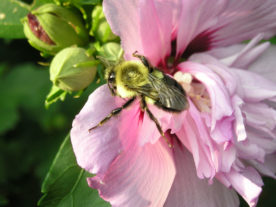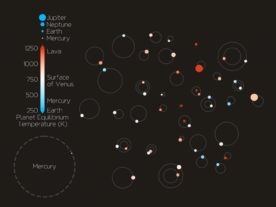It what it calls an historic step in the search for signs of life on other planets, NASA says its astronomers have detected light coming from a “super-Earth” planet 41 light years away.
It marks the first time direct light from a rocky super-Earth planet has been seen, researchers said.
The planet, called 55 Cancri e, is 25 times closer to its star (55 Cancri) as Mercury is to the Sun. New data from the Spitzer Space Telescope indicates the planet is about twice as big and eight times as massive as Earth. The side of it that faces the sun is more than a scorching 2,000 Kelvin (1,727 degrees Celsius), hot enough to melt metal. And, one year on 55 Cancri e lasts a mere 18 Earth minutes.
According to NASA, the Spitzer Space Telescope and others have been able to study this planet in the past by analyzing how the light from it changed as the planet passed in front of the star. With this new discovery, Spitzer was able to actually measure just how much infrared light comes from the planet itself.
New data from the Spitzer shows that 55 Cancri e is a “water world,” with a rocky core that’s surrounded by water which is in a “supercritical state,” meaning the water is in both liquid and gas forms, and is capped with a blanket of steam.
NASA says these new findings are concurrent with prior theories regarding the makeup of the planet
“It could be very similar to Neptune, if you pulled Neptune in toward our sun and watched its atmosphere boil away,” said principal investigator, Michaël Gillon of Université de Liège in Belgium.
Addicted to Facebook
Younger users are much more likely to become addicted to Facebook than older people, according to a new worldwide study of people who use the social networking website.
With more than 800 million active members, Facebook has become a worldwide phenomenon. Many Facebook members find themselves checking the website numerous times of day to get the latest info on their friends and their activities.
Dr. Cecilie Schou Andreassen from Norway’s University of Bergen headed the “Facebook Addiction” study. Her team also developed the Bergen Facebook Addiction Scale to measure dependency.
The team found Facebook addiction happens much more to younger users than those who are older, and that anxious and socially insecure people tend to use the website more. Andreassen believes this is because those who are anxious or insecure find it easier to communicate with others through Facebook and other social media rather than through face-to-face conversations.
According to the study, organized and more ambitious people aren’t as likely to become as addicted to Facebook, although they often use it as an important professional networking tool.
The study also found women are more at risk of developing Facebook addiction than men probably, according to Andreassen, because of the social nature of Facebook.
Andreassen’s Bergen Facebook Addiction Scale lists six warning signs.
- You spend a lot of time thinking about Facebook or planned use of Facebook
- You feel an urge to use Facebook more and more
- You use Facebook in order to forget about personal problems
- You have tried to cut down on the use of Facebook without success
- You become restless or troubled if you are prohibited from using Facebook
- You use Facebook so much that it has had a negative impact on your job/studies
Universal vaccine could eliminate need for seasonal flu shots
Canadian research has revealed a possible new way to develop an influenza vaccine that could eliminate the need for seasonal flu vaccinations.
Each year pharmaceutical companies manufacture and distribute a new flu vaccine to protect people against three different strains of influenza viruses that are expected to be most common during the upcoming flu season.
Rather than having to update a flu vaccine for each year, scientists have been at work to develop what they call a universal vaccine which protects against all types and strains of influenza.
Studying the 2009 H1N1 “swine flu” vaccine, a University of British Columbia research team found that that specific flu vaccine triggered the immune system to produce a number of antibodies that protect against many other flu viruses, including the dreaded H5NI avian (bird flu) strain of influenza.
Team leader Dr. John Schrader found that a protein in the flu virus called hemagglutinin (HA) is a lot like a flower with a head and a stem. It’s the head of this protein that binds the flu virus to the healthy human cell, like an electrical plug into a socket.
Most vaccines, according to Schrader, help the body develop antibodies that attack the head of the protein in order to prevent infection. But, since the flu virus tends to mutate quickly, that part of the HA protein changes rapidly so new and different vaccines are needed for each flu season.
But Schrader and his research team found that the 2009 H1N1 vaccine also built up antibodies that attacked the stem of the protein, thereby neutralizing the flu virus.
“The stem plays such an integral role in penetrating the cell that it cannot change between different variants of the flu virus,” said Schrader.
According to Schrader, he has evidence producing vaccines based on a mix of flu viruses circulating in animals, but not humans, should have the same effect, possibly making influenza pandemics and seasonal influenza a relic of the past.
New research pinpoints origin of the domestic horse
The domesticated horse originated in the steppes of modern-day Ukraine, southwest Russia and west Kazakhstan, mixing with local wild stocks as they spread throughout Europe and Asia, according to a new study.
Scientists from the University of Cambridge (UK) used a genetic database of more than 300 horses from across the Eurasian Steppe to reach their conclusion.
The new study finds the Equus ferus, the extinct wild ancestor of today’s domestic horse, migrated out of East Asia about 160,000 years ago, to be domesticated in the western Eurasian Steppe, their herds constantly replenished with wild horses as they spread across Eurasia.
“The spread of horse domestication differed from that of many other domestic animal species, in that spreading herds were augmented with local wild horses on an unprecedented scale,” said Dr. Vera Warmuth of the University of Cambridge’s Department of Zoology.
























People´s hearts a very apart …
There is an old say: See face don´t see heart.
How about a HEARTBOOK